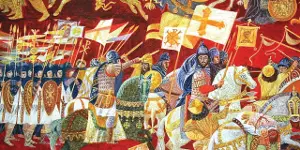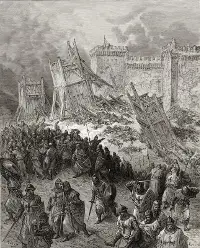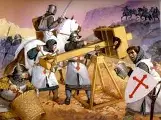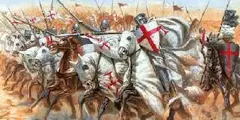|
|

Warfare during the Crusades
|

|
|
|
Share This Page
|
|
|
|
|
|
|
Follow This Site

|
 |
|
|
|
|

|
Much of the fighting during the Crusades took place in pitched battles, pitting armed soldiers against other armed soldiers, or perhaps soldiers on horseback against a combination of the two. The targets of many of the Crusaders' attacks were fortified cities, but the Muslim armies who had taken over the Holy Land also fought to control the less fortified cities and towns and the land surrounding those population centers.

The common image of the Western fighter during the Crusades is of a knight, with or without his own horse, who wears armor and a helmet, holds a shield, and wields a sword or some other deadly handheld weapon. This was certainly the description of many a rich Crusader. However, many not-so-rich and even poor Crusaders fought in these battles as well, and they wielded slightly less expensive and effective armor, shields, and weapons. Other handheld weapons included daggers, axes, and various kinds of pole-based weapons. Other fighters wielded bows and crossbows, shooting arrows and bolts, respectively. Knights and others on horseback might wield lances.
It is the image of the heavily fortified city holding out against a determined besieging army, however, that is what many people think of when they envision the Crusades. Such important and populous cities as Acre and Jerusalem were surrounded by walls, on top of which stood armed soldiers. The idea of storming a walled city was a very determined one indeed.
Attackers featured a number of deadly weapons designed to level the walls or otherwise negate the defenders' advantages:
- The battering ram is perhaps the most famous of these weapons. A large, heavy piece of wood, usually, the battering ram was gripped by a large number of men or perhaps a medieval machine and used to strike gates and walls, repeatedly; the idea was that the force of the blows would eventually weaken the wood or stone of which the gates and walls were made and allow the attacking army to storm through the resulting hole.

- The ballista was a giant crossbow-like machine that created a large amount of force behind the equivalent of a large arrow by drawing the "string" to create a large amount of tension. The last step was to "fire" whatever was loaded in the ballista, usually something that looked like a very large arrow.
- The trebuchet was basically a giant sling that could hurl a large collection of large heavy stones or other projectiles high in the air for a long way. Targets for trebuchets included the walls themselves and the defenders who manned those walls.
- The most basic of the siege weapons, the ladder enabled attackers to scale to great heights, usually to the top of walls, thereby putting an attacker on the same level as a defender, negating the advantage of the wall.
- Patrolling the siege area would also be siege towers, massive wooden and metal constructions designed to protect attackers so they could otherwise engage the city's defenders. The most common siege towers had a door near the top that would open, allowing the attackers hidden inside to storm onto the battlements, atop a city's walls.
Defenders of a walled city had a number of weapons at their disposal:

- Arrows were generally the most common defensive weapon for an army atop a city's walls. Archers would rain down arrows on attackers attempting to climb ladders up the walls, on enemy archers, on anything in the attacking force below.
- Boiling oil was another popular defensive weapon. Men, women, and even children would dump pots of super-hot water and oil over the sides of the walls, aiming to scald and scatter the attackers below. Sometimes, archers augmented this defensive tactic by firing fire arrows into the boiling oil, hoping to create a fire that would harm as many attackers as possible and, ideally, spread.
- Defenders were quite happy to throw anything over the sides of the walls, really, because anything thrown from a great enough height would have picked up a large amount of force by the time it landed on an attacker below.
|
|











